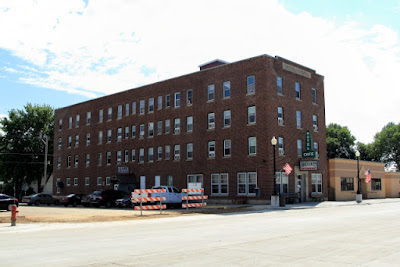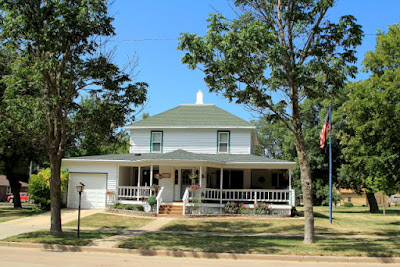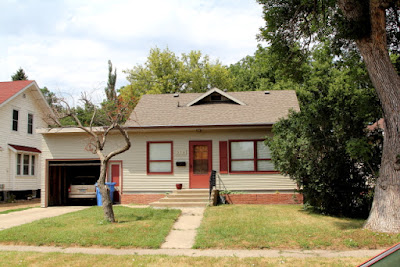Canistota (population 656) is know throughout South Dakota and the surrounding states for the Ortman Chiropractic Clinic and Hotel, which has been in business for over 90 years. The clinic attracts many Midwestern Amish people.
Canistota was platted in 1883 and named after Canastota, New York, but the name was misspelled in the application for a post office. I always remember the town's slogan as "The Best Little Town By A Dam Site;" but they must have dropped the slogan because I did not see the sign as I drove into town this time.
The school is still located on Main Street and there is a nice veterans memorial in front of the property. The house where Grandpa and Grandma Klinkel (Ed & Dora) lived has been well maintained and is located directly across the street from the school. Unfortunately, some of the other family properties have not been as well maintained.
The house where Great-Grandpa & Great-Grandma Reeter (Art & Mary) lived on Second Avenue has also been well maintained. We also drove by the Good Samaritan Society Senior Nursing Facility where Grandma Reeter lived after she fell and broke her hip when she was 90. Randy was the first Great-Great Grandchild, followed by numerous others (Great-Great-Grandma lived to be 103).
Salem (population 1,347) is located just a few miles up the road from Canistota and is the county seat for McCook County.
Salem was named after Salem, Massachusetts and at one time it was called Melas ("Salem" spelled backwards) to prevent confusion with Salena, South Dakota (now non-existent).
Hartford (population 3,025) was originally known as Oaksville, but the community was incorporated as Hartford in 1896. The town has a nice veteran's memorial.
Colton (population 687) was founded in 1897 when J.E. Colton opened a creamery on the site. Other businesses soon followed and in 1901 J.E. Colton started a newspaper called "The Colton Courier" that stayed in business for many years.
Colman (population 594) was originally named Allentown, but the name was changed to Colman when the Milwaukee Railroad ran through the area.
"Old" Madison was located on the southwest side of Lake Madison and was designated as the county seat for Lake County in 1873. Then in 1880, the Chicago, Milwaukee & St. Paul Railroad bypassed the community five miles north of town. Within a few years residents started relocating to "New" Madison (current cite), which was adjacent to the railroad and the residents wanted the county seat moved to the new location. The county commissioners refused the move to "New" Madison; so one night the safe with all of the county records was "mysteriously" moved to "New" Madison, changing the county seat without an election. The only thing left at "Old" Madison is a State Historical Marker.
"New" Madison (population 6,474) has a reputation for being a city of schools and churches and was successful in securing the Dakota Normal School, the first teacher education school in the territory. The school is now known as Dakota State University.
The house where Grandpa and Grandma Jensen (Jens & Olga) lived is locate at 514 NE Third Street, a short distance from the University.
Howard (population 858) is the county seat and the most populous community in Miner County. Howard is known for a number of firsts - the first photographs of a tornado was taken in Howard, the first public library in Dakota Territory was located in Howard, and Howard was the first municipality in South Dakota to own and operate its own wind turbines.
Carthage (population 144) was named for Carthage, New York.
The community is best known as the "Brewster Settlement" where Laura Ingalls Wilder taught her first school classes as described in her novel These Happy Golden Years. Carthage was also featured in the book Into the Wild, which documented the travels of Chris McCandless who worked in the community in the 1990s.
There is a church steeple located in the park that commemorates the various churches that have existed in Carthage over the years.
Manchester (population 0) was a small community that on June 24, 2003 was completely annihilated by a large F-4 rated tornado that was one-half to one mile wide as it crossed the town. A granite monument has been erected to commemorate the towns history and to honor the residents who had lived there.
There is also a historic marker indicating that artist-illustrator Harvey Dunn was born in 1884 near Manchester. The "Harvey Dunn Collection" of his works is located at the South Dakota State University Art Museum in Brookings.
De Smet (population 1,089) is the county seat of Kingsbury County and was made famous by the Laura Ingalls Wilder Little House books and the TV series Little House on the Prairie."
The Ingalls Homestead is located south of town and is open to the public.
Located in De Smet are the Surveyor's House, One-Room School and the Loftus Store. (The Luftus store has been expanded and another building has been constructed adjacent to the store so that you can no longer walk completely around the outside of the building.)
Brookings (population 22,056) is the fourth largest city in South Dakota and the county seat of Brokings County. It is also home to South Dakota State University, the largest university in South Dakota.
I almost did not recognize the Vern & Norma Klinkel home at 518 20th Avenue. I always remember the house being on the fringe of civilization with nothing but open fields to the east and a few twigs called trees along 20th Avenue.
Nick's Hamburger Shop is still doing well and is as crowded as ever!

































No comments:
Post a Comment